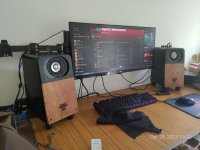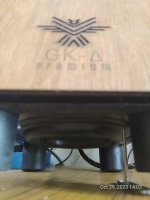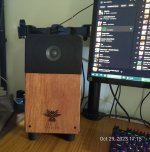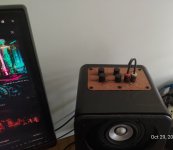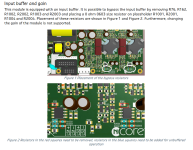@Robh3606 A parallel notch filter won't work unless used in conjunction with a series component of some sort.
This is because power amplifiers are voltage sources.
And even still, the look-back resistance for the driver is not the same as a series notch filter configuration.
Dave.
This is because power amplifiers are voltage sources.
And even still, the look-back resistance for the driver is not the same as a series notch filter configuration.
Dave.
With the Visaton AL 170 it should make sense to use such a passive serial filter since it has a severe cone resonance with H3.
www.visaton.de/en/products/drivers/woofers/al-170-8-ohm
What about a small resonance like from the Omnes Audio CX3.1? https://oaudio.de/Omnes-Audio-CX-31_1
And what about a subwoofer driver which is used way below the cone resonance frequency? Is the sound wave of the midrange or tweeter enough to get the resonance going and does a serial passive filter lowers this potential effect?
Since several years I was building every speaker digital active if i can. So now I am reconsidering everything.
Maybe a small capacitor in front of the tweeter or a small very low resistance inductor in front of the midrange also make more sense than harm? The reduction in amp self noise and amp crosstalk may be enough to get slightly better results? And it might also help to handel with some passiv introduces excitation of the cone better than the damping of the amp??
www.visaton.de/en/products/drivers/woofers/al-170-8-ohm
What about a small resonance like from the Omnes Audio CX3.1? https://oaudio.de/Omnes-Audio-CX-31_1
And what about a subwoofer driver which is used way below the cone resonance frequency? Is the sound wave of the midrange or tweeter enough to get the resonance going and does a serial passive filter lowers this potential effect?
Since several years I was building every speaker digital active if i can. So now I am reconsidering everything.
Maybe a small capacitor in front of the tweeter or a small very low resistance inductor in front of the midrange also make more sense than harm? The reduction in amp self noise and amp crosstalk may be enough to get slightly better results? And it might also help to handel with some passiv introduces excitation of the cone better than the damping of the amp??
Hallo Thomas,
Helmholtz or closed?
Continuously symmetrical signal chain?
@>all<: No Discussion intended!
Grüße,
Bernd
Helmholtz or closed?
Continuously symmetrical signal chain?
@>all<: No Discussion intended!
Grüße,
Bernd
Hello Bernd,Hallo Thomas,
Helmholtz or closed?
Continuously symmetrical signal chain?
@>all<: No Discussion intended!
Grüße,
Bernd
closed box and all digital to the Hypex plate amp. To my knowledge the amp inside the plate amp is class d and has no symmetrical output.
Do you think I don't want to discuss?
Viele Grüße
Thomas
Hallo Thomas,
“My hole in my box is the best hole in the world”. I never want to talk about something like that again.
So closed, that opens up possibilities.
For thorough filling with dampening fibers.
For a series resistor that reduces distortion.
For targeted box Q
For targeted box resonance
...
What are your targets for box Q and box resonance?
Does DSP change your targets?
I called this problems "off band noise".
Why again did you buy the best tweeter that doesn't distort?
Grüße,
Bernd
“My hole in my box is the best hole in the world”. I never want to talk about something like that again.
No Noise.all digital to the Hypex plate amp
So closed, that opens up possibilities.
For thorough filling with dampening fibers.
For a series resistor that reduces distortion.
For targeted box Q
For targeted box resonance
...
What are your targets for box Q and box resonance?
Does DSP change your targets?
Allow me a remark: All Ds (and IMDs also) in the current will work at the coil. And then there is also the cone beam narrowing at higher frequencies. Imagine you build a real wonder of controlled dispersion. And then the cone screams at you at 0° with D or IMD outside the DSP Band.since it has a severe cone resonance with H3
I called this problems "off band noise".
Why again did you buy the best tweeter that doesn't distort?
Grüße,
Bernd
I mix passive + active xover when I need better integration of bass frequency with subwoofers in a 3 way floor standers or 2 way systems with fullrange + low extention driver. That way I can play with low frequency eq and delays without affecting high range drivers to better gel with the subwoofer.
Attachments
Not true for the FA122 with several typical drivers (efficiency of about 90dB per Watt). The self noise is low but especially at low listening distance of about 1m you can hear the self noise of the amps. My question here is it worth to lower the self noise of the amp slightly by using a high pass or low pass or does the passive components degrade the signal so that the self noise is a better trade?No Noise.
I typically use a lot of damping material way more than almost any other speaker designer is using since I think I can hear the box if it isn't dampened well. I was longer time wondering why a lot of people use way less material also companies like Genelec uses not much material e.g. for it' midrange in the one series. It might introduce some none linear behavior? But the whole damping question is another topic...So closed, that opens up possibilities.
For thorough filling with dampening fibers.
For the mid range (Ohmnes audio CX3.1) I haven't calculated any Q since I will use it above the resonance frequency (x over about 500Hz).What are your targets for box Q and box resonance?
Does DSP change your targets?
For the bass (most likely Visaton AL 170) about 0.7 including the effect of the damping material.
Maybe some optional linkwitz transformation for deeper bass at low listening level. In the long run a subwoofer will be added.
The "off band noise" should be measured in the THD+noise right? Or it one problem that the cone resonance frequency is excited by the pure tone of the tweeter and you get linear distortion or isn't this a problem at all?Allow me a remark: All Ds (and IMDs also) in the current will work at the coil. And then there is also the cone beam narrowing at higher frequencies. Imagine you build a real wonder of controlled dispersion. And then the cone screams at you at 0° with D or IMD outside the DSP Band.
I called this problems "off band noise".
Why again did you buy the best tweeter that doesn't distort?
You did this out of band with in a small frequency band with a serial filter of the cone resonance which is out of band. As a thought experiment: if you simply put a resistor in series did you get any positive effects? I thought you decrease the damping factor and waste headroom and therefore it should be avoided? And as you mentioned it is a way to reduce the self noise of an amp but besides that I thought there are no positive things you get.that means increased "output" impedance as seen by driver and exactly what might be beneficial to the frequency range well above driver resonance frequency, according to the supporters of current drive.
Hmm… is that true? A driver’s voice coil and magnet will interact with with a passive XO’s RLC filter to achieve a completely different impedance sweep.The speaker doesn't know if it is driven by a passive or by an amp preceded by a passive.
It's a shame, the Stone Age of gain mismatch between DSP and amplifier still exists.Not true for the FA122 with several typical drivers (efficiency of about 90dB per Watt). The self noise is low but especially at low listening distance of about 1m you can hear the self noise of the amps. My question here is it worth to lower the self noise of the amp slightly by using a high pass or low pass or does the passive components degrade the signal so that the self noise is a better trade?
The solution requires soldering :-(
Buffer deletion 13.5 dB less amplifier gain.
Check out the screenshot
Attachments
The keyword here is mostly back EMF 😉Hmm… is that true? A driver’s voice coil and magnet will interact with with a passive XO’s RLC filter to achieve a completely different impedance sweep.
So the driver almost quite literally knows if it's being filtered passively or actively, since without proper line termination (= near perfect voltage source), this back EMF reflects back into the speaker itself, creating additional harmonics.
Yes, but...The "off band noise" should be measured in the THD+noise right?
I would make a microphone recording of the transducer in question with music. All other paths/transducers muted. Then I would filter the sound file so that only the area remains where there should actually be silence.
YesA driver’s voice coil and magnet will interact with with a passive XO’s RLC filter to achieve a completely different impedance sweep.
The RLC in series to the transducer will show up as a high impedance peak in the sweep. This will reduce the current in the voicecoil at the chosen frequency. Hence the transducer will not SPL that frequency. No current no sound. If that frequency is off band, the series RLC will be useful to delete the harmonics in the current stemming from nonlinear Distortion.
For example you design a series RLC for say 4000 Hz it will delete:
D4 from 1000 Hz fundamental
D3 from 1333 Hz fundamental
D2 from 2000 Hz fundamental
No, other way round ;-)The keyword here is mostly back EMF 😉
So the driver almost quite literally knows if it's being filtered passively or actively, since without proper line termination (= near perfect voltage source), this back EMF reflects back into the speaker itself, creating additional harmonics.
The back EMF voltage hits a short at the amps loudspeaker output (= near perfect voltage source). A voltage hitting a short results in infinite high current. This current flows through the voicecoil and makes sound.
Now, this back EMF voltage contains the harmonics introduced by the nonlinear coil/magnet motor.
Last edited:
This is exactly why even on a 25 driver (full range TC9’s) line array driven by a single amp with upstream DSP, @wesayso implemented a rather elaborate conjugate filter at the speaker level to flatten the impedance peaks so that the amp can drive the speaker better.


I think this is the best for starters. In some of my projects I switched to MiniUSB as the holy grail that fixes everything. After months of disappointment and more grey hair I would have been grateful to these well documented and compact info from the link. For me active is a good way to match the spl, extend the lowrange, and is useful for integrating a woofer to a wideband or two-way speaker. This is now leaving the objective ground but for me active killing peaks and so on is a pain and killed all the liveliness of my speakers. Best results I achieved with passive Zobel for impedance rise and notch filters for a smoother and non-shouty speaker in the Crossover-Region. AFAIK also the pros from Geithain are doing a mixture of passive and active. Going active is simple but doing it right ain't 😉
Edit: from my experience the class-d amps as the hypex are working much better soundwise with a linear impedance, that's why I always do a impedance linearization. Depending on the XO point it can be overkill but gives you also more flexibility if you do want to experiment with the settings
Last edited:
That's interesting, because the feedback Hypex has always been using is actually there to make the amplifier totally impedance independent?from my experience the class-d amps as the hypex are working much better soundwise with a linear impedance
I cannot talk for the last iterations but I switched from class-d to ab/a and the sound signature was again on a different level. It really depends on your design goals but I didn't like what I got from Tripath/IcePower/Hypex amps without impedance correction but as stated it's more on the subjective side and I got no noise floor measurements for proving any point. Just not my cup of tea especially for wideband speaker.
I should also mention that I realised that crossover topologies of higher order usually are also not pleasing to me but won't blame anyone for trying so. It's about the proper integration and I'm no expert in this field. A tiny class-d for desktop use on a budget or especially for woofers I'm totally okay with it.
Beside the amp I also get more or less rid of my DSP because it made things just more complex and not better.
Started to invest in room-treatment and could improve the worst issues in an analogue way with wellplaced bookshelves and so on - no rockwool, no fancy skyline diffuser stuff.
For what I prefer the digital approach is the experiment phase, after this switching to an discreet build active crossover improved the entire sound by alot (I assume better noise floor) with the downside of having the crossover and one amp per channel.
The hypex plate amps are very comfy to use and result in a great WAF what's the best measurement in the end.
I should also mention that I realised that crossover topologies of higher order usually are also not pleasing to me but won't blame anyone for trying so. It's about the proper integration and I'm no expert in this field. A tiny class-d for desktop use on a budget or especially for woofers I'm totally okay with it.
Beside the amp I also get more or less rid of my DSP because it made things just more complex and not better.
Started to invest in room-treatment and could improve the worst issues in an analogue way with wellplaced bookshelves and so on - no rockwool, no fancy skyline diffuser stuff.
For what I prefer the digital approach is the experiment phase, after this switching to an discreet build active crossover improved the entire sound by alot (I assume better noise floor) with the downside of having the crossover and one amp per channel.
The hypex plate amps are very comfy to use and result in a great WAF what's the best measurement in the end.
a line level notch does only solve the FR but not the distortion problem. The app note explains this.I wouldn't assume there's an optimal solution. Everything we do usually involves trade-offs. (And you've just highlighted a few.)
With all due respect to Lars Risbo, I think this is a solution looking for a problem, in most cases.
if you have the ability at line-level to create an appropriate resonance notch filter, you are essentially solving the problem.
Dave.
@lrisbo
Uh, no. But I do understand your point and premise perfectly well.
Line level notch filtering ("essentially") does solve the distortion problem because you're using active means to not excite the resonance to begin with.
If you look back at Post #8, I did do some comparison testing with a Seas aluminum driver to confirm this. I noted some slight reduction in distortion using a passive notch filter vice filtering at line level.
Dave.
Uh, no. But I do understand your point and premise perfectly well.
Line level notch filtering ("essentially") does solve the distortion problem because you're using active means to not excite the resonance to begin with.
If you look back at Post #8, I did do some comparison testing with a Seas aluminum driver to confirm this. I noted some slight reduction in distortion using a passive notch filter vice filtering at line level.
Dave.
no. the resonance will be excited by harmonics (driver distorsion - also amp distorsion, but that's probably neglible).because you're using active means to not excite the resonance to begin with
this can be adressed by passive filter, but not by the active one.
as I mentioned:
so e.g. if you reduce a 4.5 kHz peak (outside used frequency range) with a notch you also reduce H3 for a 1.5 kHz tone in the useful frequency range.
- Home
- Loudspeakers
- Multi-Way
- Combine passive and active crossover for better sound
